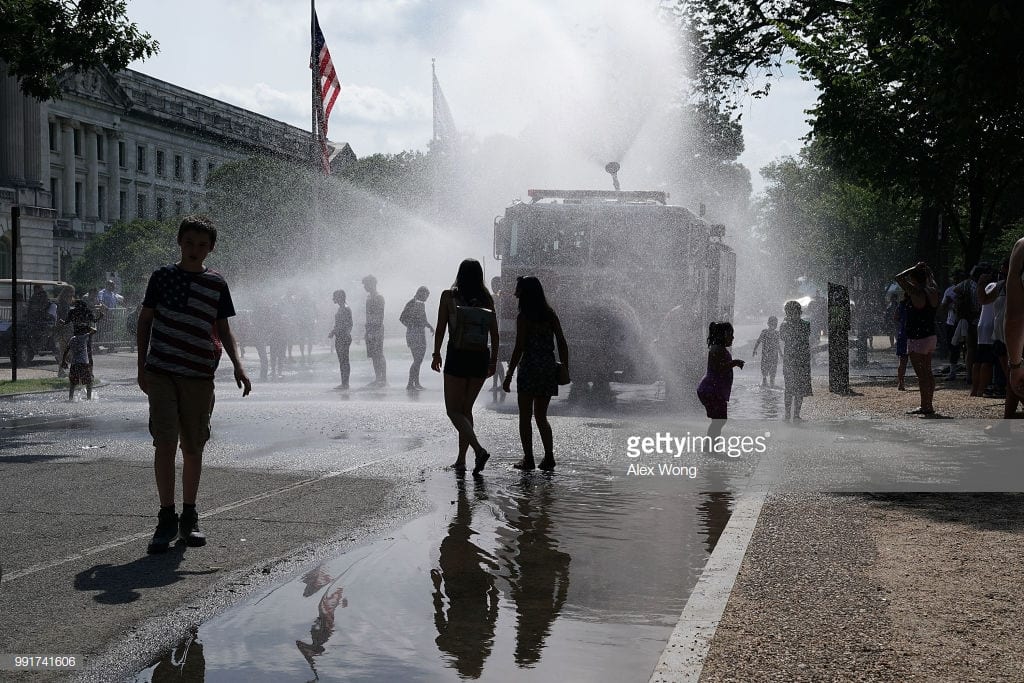BY MARIA VIRGINIA OLANO, JULY 19th 2018
As summer rolled around, so did the terrifying headlines of heat waves and their death tolls across the country. Not long ago I wrote about the effects of storm surge flooding in Boston and along the coast of the state, which caused record floods and damage. As the seasons changed, so have the weather threats, yet one thing remains constant: a pattern of extremes, which is what climate science has been warning of for decades.
How is it then, that we continue to talk about climate change as a concern for the future?
Deadly Heat
Extreme heat kills more Americans yearly than any other weather-related event, with the CDC estimating upwards of 600 fatalities each year. In California this past week, triple-digit temperatures shattered records and caused tens of thousands of Los Angeles residents to lose power for days. More than 30 deaths have been linked to a heat wave that hit Quebec earlier this month, and over 90 million Americans were under some sort of heat watch, warning or advisory over the past few weeks.
Heat waves are more than just uncomfortable, they are dangerous, deadly, and the most obvious manifestation of a warming climate. They are repeated events of increased prevalence around the world, which are only forecasted to get worse as we keep pumping heat trapping gases into the atmosphere.
A 2017 study found that about one-third of the world’s population already lives somewhere where the daily temperatures are considered lethal more than 20 days a year.
Plummeting Air Quality
Heat waves present compounding problems, most notably they have a direct impact on air quality. Increased heat and sunlight lead to increased air pollution, which is why heat waves are a very significant public health concern. This mainly due to the formation of ozone. While ozone in the stratosphere (aka. The ozone layer) is good and in fact necessary to protect the Earth from solar radiation, at ground level the molecule is a dangerous pollutant, one of the main components of smog.
Burning fossil fuels releases the carbon dioxide that causes climate change. The same fuels, used in vehicles and power plants, produced other dangerous pollutants such as ground level ozone and particulates, which cause respiratory problems and disproportionately harm children, the elderly and those with pre-existing illnesses. The rate at which this ozone is produced increases with temperature, so the hotter it is, the more ozone pollution there will be. That process, combined with the lack of wind on hot days, is why smog tends to hang around on summer days.
Costs to human health from air pollution averaged $188 billion a year over the past decade, while losses from extreme weather events such as hurricanes and wildfires cost the U.S. more than $300 billion in damage last year alone.
An Environmental Justice Issue
Thanks to the “urban heat island effect,” cities are significantly warmer than their surrounding suburbs, exurbs, and rural areas. However, there are some stark differences within cities as well in terms of the impacts of extreme heat. Long histories of gentrification, disinvestment in minority communities, as well as compounding social vulnerabilities also makes extreme heat a social justice issue.
A 2013 study based on census data from the year 2000, showed that people of color are up to 52 percent more likely to live in urban heat islands than white people. As a result, they face more health risks during a heat wave. Heat-related fatalities are entirely preventable, but they occur mainly in already vulnerable social groups, such as children, the elderly, those without access to air conditioning or those in neighborhoods and communities that lack parks and trees. People with chronic medical, mental health, or developmental conditions are also at greater risk.
A Low Carbon Future
Unlike other natural disasters, extreme heat is one that we can surely know will happen every year during the summer. Heat waves also exacerbate another pressing public health concern in making air quality worse and more dangerous for our communities. The more carbon we continue to pump into the atmosphere, the worse heat we will get and in turn, the worse our air quality will be.
For these reasons, it is imperative that our cities address the issue and actively pursue strategies to both change our physical environment to reduce the drivers of extreme heat while protecting the most vulnerable.
Investing in our communities is a way to start. We need to think about building the social infrastructure and social capital that has been proven to increase resilience in communities and in fact save lives during extreme events (we have a whole podcast episode on this topic, check it out here). Other physical changes may also be needed to mitigate this effect, some ideas already gaining momentum are green roofing, creating green spaces, painting roads and pavement white to reflect some of the heat. These however, will only be successful if done equitably and purposefully to address some of the already existing environmental justice concerns that plague communities across the country.
Most importantly, we have to stop thinking and talking about climate change as a concern for the future, or an issue that will impact future generations. We have overwhelming evidence and are actually living through the deadly effects of decades of pumping our atmosphere with greenhouse gases. It is time we call it what it is and stop acting so surprised when we continue to flood during the winter, when our cities continue to be hit by hurricanes, and when the heat continues to be unbearable during the summer. We must therefore stop pumping our atmosphere with the gases that are so clearly harming us.
 MARIA VIRGINIA OLANO, COMMUNICATIONS DIRECTOR
MARIA VIRGINIA OLANO, COMMUNICATIONS DIRECTOR









